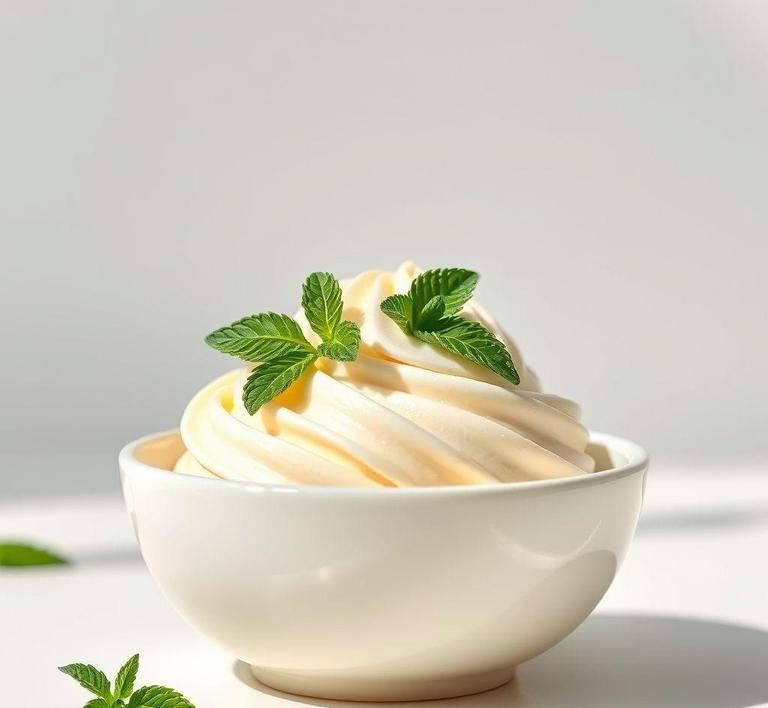Refreezing soya ice cream might seem like a simple task, but there are a few things you need to know to keep that creamy texture intact! Whether you’ve left it out too long or just want to save leftovers, it’s important to follow the right steps to prevent ice crystals from forming and ruining your favorite dairy-free treat. In this guide, we’ll walk you through the best practices for refreezing soya ice cream so it stays smooth, delicious, and as close to fresh as possible. Get ready to enjoy your soya ice cream just like the first scoop!
Can You Refreeze Soya Ice Cream?

Soya ice cream, a popular plant-based alternative to traditional dairy ice cream, is loved not just by vegans but also by the lactose-intolerant and health-conscious alike. But like all frozen desserts, it’s not immune to temperature fluctuations – and this raises the common question: can you refreeze soya ice cream once it has melted?
The short answer is yes – but with significant caveats.
Refreezing soya ice cream is technically possible, provided it has been kept within a safe temperature range (ideally below 40°F or 4°C) and hasn’t been left out for more than 1-2 hours at room temperature. However, safety isn’t the only concern; the texture, taste, and structural integrity of the ice cream may be greatly compromised.
Unlike dairy ice cream, which has a specific fat-to-water ratio and stabilizers that help it re-emulsify somewhat when refrozen, soya ice cream relies on plant proteins and emulsifiers that are often more sensitive to thaw-refreeze cycles. Once thawed, the microscopic air bubbles that give ice cream its creamy mouthfeel collapse, and ice crystals begin to form and grow. This leads us to the next critical part – how to refreeze it properly if you must.
How To Refreeze Soya Ice Cream?
If you’ve accidentally left a tub of your favorite soya-based dessert out on the counter and want to save it, here are some best practices for refreezing it with minimal quality loss:
-
Assess the Condition
- If the soya ice cream has been fully melted and left out for more than two hours, discard it to avoid potential bacterial contamination.
- If it’s only partially softened and was refrigerated or exposed briefly to room temperature, it’s generally safe to refreeze.
-
Stir Before Refreezing
- Give the softened ice cream a gentle but thorough stir to redistribute any liquid, fats, and air. This can help reduce large ice crystal formation when refrozen.
-
Use Airtight Storage
- Transfer the soya ice cream into a clean, airtight container if the original packaging has been compromised. Exposure to air during freezing leads to freezer burn and textural damage.
-
Freeze Quickly
- Place the container in the coldest part of your freezer (usually at the back). The faster it refreezes, the smaller the ice crystals and the better the texture.
-
Avoid Repeating the Cycle
- Every thaw-refreeze cycle degrades the quality further. Ideally, avoid doing this more than once.
Quality Impact
Refreezing soya ice cream is not without consequences – and these are worth understanding in detail.
-
Texture Degradation
- The most noticeable change is in texture. Once the delicate emulsion of water, plant-based fats, sugars, and stabilizers is disrupted, it’s very difficult to recreate that original silky smooth consistency. Refrozen soya ice cream tends to be grainy, icy, or gummy.
-
Flavor Loss
- Soya ice cream, like all frozen desserts, contains volatile compounds that contribute to its flavor. During melting, these aromas can dissipate or oxidize. Upon refreezing, the flavor may become muted or slightly “off”.
-
Structural Integrity
- The aerated structure – the tiny air pockets introduced during churning – collapses when ice cream melts. This gives the ice cream its light, scoopable quality. Once lost, you’ll find the refrozen product dense and harder to scoop.
-
Separation Issues
- Plant-based ice creams use different stabilizers (like guar gum, carrageenan, or locust bean gum). When thawed and refrozen, these can break down or separate, leading to a layer of icy liquid atop a chunky base.
While it’s technically safe to refreeze soya ice cream under the right conditions, doing so can significantly compromise the quality. If safety conditions are met (minimal time at room temperature and no signs of spoilage), and you’re willing to accept some loss of texture and flavor, refreezing is a viable short-term solution. However, the ideal approach is to portion your ice cream carefully, avoid extended thawing, and return it promptly to the freezer after serving.
In essence, soya ice cream is a delicate delight – treat it with the same care you would a fine sorbet or an artisanal gelato. A little foresight goes a long way in preserving its creamy charm.
Is It Safe To Refreeze Soya Ice Cream?
At the heart of this question lies one of food safety and texture integrity. Technically, it is possible to refreeze soya ice cream under certain controlled conditions, but it comes with significant caveats.
Soya ice cream, like dairy-based versions, is a frozen emulsion-often made with a base of soya milk, stabilizers, sugars, and fats. This delicate structure can be compromised when thawed and refrozen. The safety of refreezing depends on how long the product has been left out, the temperature at which it thawed, and whether it has been contaminated.
If your soya ice cream has only softened slightly and remained below 40°F (4°C)-say, after a quick transfer from store to freezer-then refreezing it is generally safe. However, if it has melted completely and sat at room temperature for more than two hours, harmful bacteria could proliferate, making it unsafe to refreeze and consume.
Moreover, freezing and thawing alters the consistency. Upon refreezing, soya ice cream may develop a grainy or icy texture due to the disruption of its original emulsion, diminishing the creamy experience you initially enjoyed.
Signs That Soya Ice Cream Should Not Be Refrozen
It’s not always easy to judge whether your tub of soya goodness is still safe to eat, but here are clear warning signs that it’s time to let go:
- Complete Melt: If the ice cream has turned into a thick liquid, especially at room temperature, it’s been in the danger zone (above 40°F) too long. Bacterial growth becomes a real concern.
- Sour or Off Odor: A change in smell is a big red flag. Even plant-based products can spoil. A sour, fermented, or otherwise ‘off’ odor signals microbial activity.
- Texture Transformation: Once refrozen, if the surface has a frosty, icy layer, it indicates previous thawing. This doesn’t necessarily mean it’s unsafe, but it likely won’t taste the same.
- Color Change: Any unusual color-like yellowing or dullness-can indicate spoilage or ingredient separation.
- Strange Taste: If the flavor is off or has an aftertaste, it’s best not to risk it, especially since off-flavors can indicate spoilage not visible to the eye.
Common Refreezing Mistakes
Even the most well-intentioned plant-based eater can make simple errors. Here are some of the most common pitfalls:
⛔ Leaving It Out Too Long: The most frequent mistake is underestimating how quickly bacteria grow. Just two hours at room temperature is enough to compromise safety.
⛔ Scooping with a Dirty Utensil: Cross-contamination can introduce bacteria. Always use a clean scoop, especially if you plan to refreeze the leftovers.
⛔ Refreezing Multiple Times: Each freeze-thaw cycle increases the chance of bacterial growth and deteriorates the product’s texture further.
⛔ Ignoring the Use-By Date: Even if the product was stored correctly, it has a shelf life. Don’t refreeze if the expiration date has passed or is near.
⛔ Thawing the Entire Tub Instead of Portioning: It’s better to scoop out what you need rather than allowing the entire container to thaw. Partial thawing of the full container can encourage uneven temperatures-perfect for bacterial breeding.
Tips And Tricks
While it’s best to enjoy your soya ice cream in one go, life doesn’t always allow that. So, here’s how to manage those creamy leftovers wisely:
✔ Portion Control: Before serving, divide the soya ice cream into smaller, airtight containers. This lets you thaw only what you need and keep the rest undisturbed.
✔ Freeze Fast: If you decide to refreeze, do it as soon as possible. The less time it spends at temperatures above 40°F, the better.
✔ Label with Dates: Use a permanent marker to label when you first opened and when you refroze the ice cream. This helps track how long it has been stored and avoid guessing games later.
✔ Use for Recipes: If the texture is off after refreezing, repurpose it! Blend it into smoothies, use it in plant-based milkshakes, or mix into vegan baked goods. The taste remains pleasant, even if the texture suffers.
✔ Invest in a Freezer Thermometer: Keeping your freezer at a constant 0°F (-18°C) ensures any refrozen product remains as safe as possible.
Conclusion
Refreezing soya ice cream is a topic where safety, science, and culinary enjoyment intersect. While technically safe under certain conditions, refreezing is a delicate game that can compromise both texture and safety. The best approach? Only refreeze if the ice cream has stayed cold and hasn’t completely thawed. Keep an eye out for spoilage signs, avoid common mishaps, and consider practical tips to make your frozen treats last longer.
Ultimately, soya ice cream is a delightful indulgence. With a little care, you can enjoy it safely, even beyond its first scoop. But when in doubt, it’s better to treat yourself to a fresh pint than risk a spoiled spoonful.


